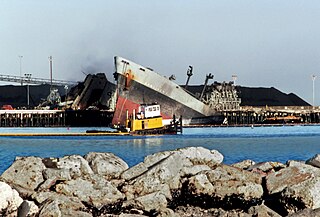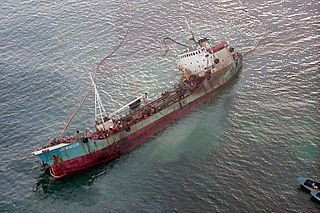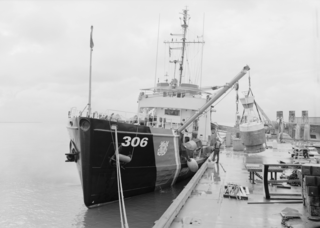Related Research Articles

An oil spill is the release of a liquid petroleum hydrocarbon into the environment, especially the marine ecosystem, due to human activity, and is a form of pollution. The term is usually given to marine oil spills, where oil is released into the ocean or coastal waters, but spills may also occur on land. Oil spills can result from the release of crude oil from tankers, offshore platforms, drilling rigs, and wells. They may also involve spills of refined petroleum products, such as gasoline and diesel fuel, as well as their by-products. Additionally, heavier fuels used by large ships, such as bunker fuel, or spills of any oily refuse or waste oil, contribute to such incidents. These spills can have severe environmental and economic consequences.

Exxon Valdez was an oil tanker that gained notoriety after running aground in Prince William Sound, spilling her cargo of crude oil into the sea. On 24 March 1989, while owned by the former Exxon Shipping Company, captained by Joseph Hazelwood and First Mate James Kunkel, and bound for Long Beach, California, the vessel ran aground on the Bligh Reef, resulting in the second largest oil spill in United States history. The size of the spill is estimated to have been 40,900 to 120,000 m3. In 1989, the Exxon Valdez oil spill was listed as the 54th-largest spill in history.

Falls of Clyde is the last surviving iron-hulled, four-masted full-rigged ship, and the only remaining sail-driven oil tanker. She was designated a U.S. National Historic Landmark in 1989, but deregistered in 2024 due to her condition. Hawaii is seeking proposals to scrap the ship. She is currently not open to the public.

SS Sansinena was a Liberian oil tanker that exploded in Los Angeles harbor on 17 December 1976 at 7:33pm. She was docked at berth 46 at Port of Los Angeles in San Pedro, California.
SS Atlantic Empress was a Greek oil tanker that in 1979 collided with the oil tanker Aegean Captain in the Caribbean, and eventually sank, having created the fifth largest oil spill on record and the largest ship-based spill having spilled 287,000 metric tonnes of crude oil into the Caribbean Sea. It was built at the Odense Staalskibsværft shipyard in Odense, Denmark, and launched on 16 February 1974.
The MV Sea Empress was a single-hull Suezmax oil tanker that ran aground at the entrance to the Milford Haven harbour on the southwest coast of Wales in February 1996. The ensuing oil spill, Britain's third largest oil spillage and the 12th largest in the world at the time, devastated a considerable area of local coastline and killed many birds, and continued to affect the Pembrokeshire coast for years afterwards.

MV Argo Merchant was a Liberian-flagged oil tanker built by Howaldtswerke in Hamburg, Germany, in 1953, most noted for running aground and subsequently sinking southeast of Nantucket Island, Massachusetts, causing one of the largest marine oil spills in history. Throughout the vessel's troubled past, she was involved in more than a dozen major shipping incidents including two other groundings; once in Indonesia while named Permina Samudra III, and again in Sicily while named Vari; and a collision in Japan.

Ship grounding or ship stranding is the impact of a ship on seabed or waterway side. It may be intentional, as in beaching to land crew or cargo, and careening, for maintenance or repair, or unintentional, as in a marine accident. In accidental cases, it is commonly referred to as "running aground".

MV Jessica was an oil tanker that was involved in an oil spill in the Galápagos Islands, a chain of islands 972 km (525 nmi) west of continental Ecuador, of which they are a part. The ship was registered in Ecuador and owned by Acotramar. On the evening of 16 January 2001, Jessica ran aground at Wreck Bay, at the entrance to the port of Puerto Baquerizo Moreno, the capital of the Galápagos Province, located on the southwestern coast of San Cristóbal Island. The ship was carrying 600 tons of diesel oil and 300 tons of intermediate fuel oil. The diesel was destined for the fuel dispatch station on Baltra Island, while the fuel oil was destined for the tourist vessel Galapagos Explorer.
The SS Wafra oil spill occurred on 27 February 1971, when SS Wafra, an oil tanker, ran aground while under tow near Cape Agulhas, South Africa. Approximately 200,000 barrels of crude oil were leaked into the ocean. The larger part of the ship was refloated, towed out to sea, and then sunk by the South African Air Force to prevent further oil contamination of the coastline.

NOAAS Townsend Cromwell was an American fisheries research vessel that was in commission in the National Oceanic and Atmospheric Administration (NOAA) fleet from 1975 to 2002. Prior to her NOAA career, she was in the United States Fish and Wildlife Service's Bureau of Commercial Fisheries fleet from 1963 to 1975 as US FWS Townsend Cromwell.
The SS Arrow was an oil tanker built by Bethlehem Steel Company, Sparrows Point, Baltimore, Maryland, in 1948 as the tanker Olympic Games.
MVABT Summer was an oil tanker which was built at the South Korean shipbuilding yard of Ulsan and launched in 1974. The vessel was 344 meters in length and almost 54 meters in breadth. While under a Liberian flag, fully laden with Iranian crude and en route to Rotterdam, she sank 700 nautical miles off the Angolan coast. An unexplained explosion occurred on May 28, 1991, and the ship and its cargo began to burn. Five of the crew of thirty-two were killed in the incident, four of whom were initially reported as missing. The following day, a slick 32 kilometres (20 mi) long and 7 kilometres (4.3 mi) wide began to form. The ship continued to burn for three days before sinking on June 1. The vessel's 260,000 tonne cargo of oil was lost, leaving a visible slick on the ocean surface of approximately eighty square miles. Attempts to locate the wreck following the incident proved unsuccessful.
The Sanchioil tanker collision occurred on 6 January 2018 when the Panamanian-flagged, Iranian-owned tanker Sanchi, with a full natural-gas condensate cargo of 136,000 tonnes, sailing from Iran to South Korea, collided with the Hong Kong-flagged cargo ship CF Crystal 160 nautical miles (300 km) off Shanghai, China. Sanchi caught fire shortly after the collision; after burning and drifting for over a week, it sank on 14 January.

USCGC Buttonwood (WAGL-306/WLB-306) was a Mesquite-class sea-going buoy tender operated by the United States Coast Guard. She served in World War II as well as a variety of domestic missions. After decommissioning she was acquired by the Dominican Republic Navy and renamed Almirante Didiez Burgos. She is still active as the flagship of the Dominican Navy.
In late December 1989 and early January 1990, an estimated 70,000 tons of crude oil spilled from the Iranian oil tanker Khark 5 after she suffered a hull breach on 19 December in the mid Atlantic Ocean off of Morocco.
MV Kurdistan, initially named Frank D. Moores, was an oil tanker built in 1973 for the American-Canadian trade. In 1979, she became stuck in ice and suffered a cataphoric structural failure, resulting in her bow sheering off and the spilling of 10,000 tons of oil off Nova Scotia, Canada.

Böhlen or Boehlen was an East German oil tanker that sank during a storm off the Île de Sein on 14 October 1976, causing the death of 25 crew members and an oil slick on the coast of mainland Finistère and the Île de Sein. Three other people died in the operations to pump and clean up the oil from the Böhlen.
Epic Colocotronis was an oil tanker that caught fire and sank near Puerto Rico in 1975. The sinking of the Greek-flagged vessel resulted in an oil spill of an estimated 18,000,000 US gallons.
References
- ↑ "Largest Oil Spills Affecting U.S. Waters Since 1969". Office of Response and Restoration. NOAA.
- 1 2 3 4 5 6 "MV Hawaiian Patriot (+1977)". Wrecksite. Retrieved April 5, 2017.
- 1 2 3 4 "Tanker Explodes In 50‐Mile Slick West of Honolulu". The New York Times. February 25, 1977. Retrieved April 5, 2017.
- 1 2 "Claim Paid in Tanker Sinking". The New York Times. March 3, 1977. Retrieved April 5, 2017.
- ↑ "1976: A Winter of Ship Accidents". Office of Response and Restoration. NOAA. November 10, 2016.